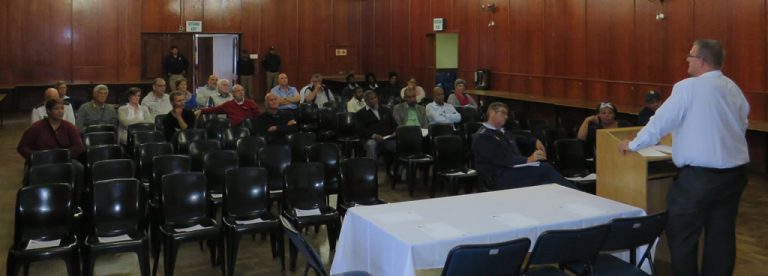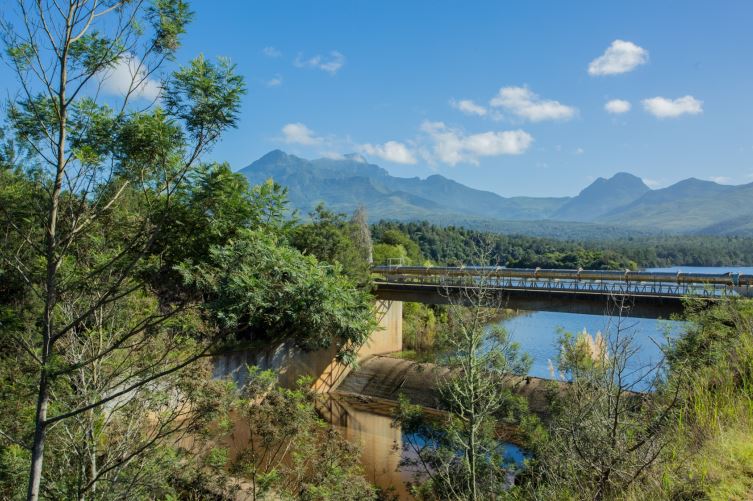The George OCC Wheelchair race is happening on 14 September 2019!Visit their website for more detail and registration forms.
www.georgeocc.co.zaA wheelchair race exclusively for disabled athletes!
And – every year it is getting bigger and better! The number of entries has increased dramatically, with disabled athletes and other persons in wheelchairs flocking to this annual event.The Challenge is not only unique as being the first and only event exclusively for the disabled in South Africa, but it is staged in the picturesque town of George, in the heart of the spectacular Garden Route in the Western Cape, situated at the foot of the splendour of the Outeniqua Mountains.Athletes in racing wheelchairs, adapted bicycles, hand cycles, basketball chairs and ordinary wheelchairs have made this into the premier sporting event for the disabled on the South African sporting calendar. It undoubtedly has the potential to develop into one of the best events of its kind in the world!
Stakeholders meet to discuss people living on the streets
The George Municipality yesterday hosted a meeting to discuss the impact that an increasing number of vagrants and homeless people are having on business and residents in and around the CBD.Social Development Officer Estelle Fredericks said while the homeless issue was strictly speaking not a municipal mandate (it is that of the National Department Social Welfare), the municipality recognised the wider impact the matter had and would continue with its varied approach to address what it can. “The municipality is already doing whatever is possible within the resources available to us and we now ask our businesses and communities to help us come up with new and sustainable solutions.”The George Municipality takes regular surveys to determine how many people are living on the street and registers those who are willing on its database. At last count, there were 94 such people in George. The municipality’s Social Development unit assists with reuniting people with their families, obtaining ID documents, helps with compiling CVs and applying for jobs. The department also heads up the People Living on the Streets Forum, which coordinates with a wide range of roleplayers including SAPS and the National Departments of Social Welfare, Justice, Internal Affairs and Labour.Community and Social Development Services Portfolio Councillor Sean Snyman said it was important to distinguish between homeless people, who had truly lost everything, and vagrants who chose to live on the streets. “It may sound harsh, but there are families out there who should be caring for their own and we make every effort to reunite such vagrants with their people. We also recognise that a large part of the problem relates to drugs – we can’t have job creation projects when the people are not employable. In this regard, the municipality is currently putting a business plan together with the goal of providing a space where a drug rehabilitation centre and related support structures can be established.”About 30 people attended the meeting which included local business, church and social organisations and people living on the streets.It was agreed that there was an urgent need for a night shelter, substance abuse rehabilitation centre and a social rehabilitation centre.The Cremhog homeless facility, which had been on the cards for some time but where gaps in the business plan was hindering implementation, also came under discussion. Attendees had indicated they were willing to work with Cremhog to help address the gaps in their business plan to coincide with the norms and standards required for similar centres. Organisations and individuals said they would be willing to render services at the centre.The decision was made to invite all interested parties to the next People Living on the Streets Forum meeting to discuss the Cremhog proposal. Attendees also affirmed their willingness to become part of the forum.
George Nostalgie
Soos ek vandag oor die groen Ouentiqua berg staar en die koel Kaapse wind waai deur my hare kom die vragie by my op, “Wat maak George so uniek, wat is dit van hierdie dorpie wat ‘n mens se voetjies net hier wil wortel skiet, so asof George jou gevange neem in sy prag beeld. Dan kom die antwoord so in my stil gees op, die mense. Die mense van George is net anders. Soveel geskiedenis van hierdie dorpie, ‘n skatkus van onberykte stories.Stories van ‘n dorpie se ontsaan, stories van liefde, stories van mense wat in eenheid staan as die nood druk, stories van besigheid skepping, stories van kindwees en in vryheid kan wil uit leef. As ek moet dink wat die woord gemeenskap beteken se die naam George alles.Daar is altyd aktiewieteite iewers in George, altyd iets te doen vir die gesin en pret is die hoof bestandeel. Ons is ryk in kulure, ryk in menswees en met mekaar ‘n stukkie van onsself te deel. George is my eie sprokies land, ‘n stukkie aarde ‘n stukkie hemel.George is klein en groot, klein genoeg jy loop altyd bekende gesiggies raak, groot genoeg jy ontmoet elke dag weer nuwe mense.As ek moet dink wat hierdie dorpie se wiele elke dag aan die rol het, is dit elke persoon wat sy deel doen, van ons munisipale werkers, ons skole, ons besighede tot die mense wat seker maak elke mens en dier is veilig.George laat my dink aan ‘n beskrywing van vrolikheid, eenheid, spontaanheid, vriendelikheid, opregtheid, maar as ek praat van George, praat ek van elke persoon in hierdie dorpie, want dit is die mense die opregtheid van harte wat hierdie stukkie hemel, stukkie aarde ‘n tuiste maak vir almal.Elke week gaan ek ‘n Love George Nostalgie met julle deel, daardie ietsie wat ons uniek maak, daardie rykdom skat van stories van George mense. Stories wat ons almal se hartsare sal speelSo ek nooi jou uit om elke week saam met my die skatkus van George se nostalgies te ondek.Moenie ons skattejag stories misloop nie.As jy graag jou storie wil vertel:Lodene Van Blerk
0743369185
lodenevanblerk@gmail.com
George Landbou Skou
Die Outeniqua Skougenootskap bestaan reeds 159 jaar en bied jaarliks een van die grootste en opwindendste landbouskoue in die Suid-Kaap aan. Hierdie wonderlike gebeurtenis herhaal homself elke Augustusmaand op die George Skougronde en is ‘n hoogtepunt onder die boeregemeenskap. In 2019 beplan ons meer betrokkenheid van die publiek, meer programme en vermaak wat die hele gesin gaan bederf.

Boots and Boogie Country Dance
Friday, 24 May 2019
George Showgrounds
R 120 pp
Tickets and info: Joey
Cell: 0824648537
Garden Route SPCA
044 – 878 1990
George Connect Friday 9am
George Connect is a movement that is meeting 9 am on Fridays. Join us to connect as Ministry, Business and Community and collectively with our God-given gifts, we can impact the city of George. We all have the same mandate, we all have the same passion about the city and that is to establish God’s Kingdom in George so that we as the Body of Christ can have a meaningful and lasting impact in the city and region.
Garden Route Dam area no-go zone as contractors go on site next week
Contractors for the raising of the Garden Route Dam spillway are expected to go on site next week (week of 13 May 2019) at which time the site and an extended surrounding area will be closed to the public for safety reasons.In addition to heavy vehicles on winding plantation roads and major excavations at the dam wall and above the dam, clearing of alien vegetation right around the dam will mean the presence of dangerous equipment including woodchippers, chain saws and cutters – not to mention falling trees, snakes and other wildlife disturbed by the temporary commotion. George Municipal Manager Trevor Botha made an urgent appeal to all hikers, cyclists, canoeists and other outdoor enthusiasts to stay clear of all plantation and forest terrain, tracks and roads south of the train tracks above the dam. “The work site is much larger than just the area directly adjacent to the dam and is potentially extremely dangerous for people who are not meant to be there. While it may be temporarily inconvenient for regular users of the terrain to find alternative outdoor space for a while, the long-term benefits of a higher dam wall and less invasive species in their natural playground will reap its own rewards.“Please do not be tempted to ignore signage because it looks like a site is not active. There is a lot that will be happening in areas that may not be obvious and visible, and areas where work is underway may be unstable and should not be entered just because workers or equipment do not seem to be around.“A special appeal is being made to cyclists to please find routes outside this area and to not take any chances. Heavy vehicles will be using almost all the plantation and forest roads that cyclists frequent. Cyclists speeding down mountain paths run the risk of encountering large vehicles on winding plantation roads and they may not be able to stop or get out of the way in time if they come upon a truck. The area is always considered a high-risk site 24 hours, seven days a week. Ongoing safety risk reviews will be carried out and areas will be opened to public access only if it is considered safe for general access.“While every effort will be made to put up signage at as many points of access as possible, the area is not fenced, and the municipality will rely on citizens to help spread the word and to warn and discourage people from accessing the area. Ongoing messaging on several municipal communication channels will also take place.“The municipality thanks residents and visitors for their support and patience during this project. It will be a temporary inconvenience but will provide longer term water security in a changing climatic environment,” said Mr Botha.
George Municipal Manager Trevor Botha made an urgent appeal to all hikers, cyclists, canoeists and other outdoor enthusiasts to stay clear of all plantation and forest terrain, tracks and roads south of the train tracks above the dam. “The work site is much larger than just the area directly adjacent to the dam and is potentially extremely dangerous for people who are not meant to be there. While it may be temporarily inconvenient for regular users of the terrain to find alternative outdoor space for a while, the long-term benefits of a higher dam wall and less invasive species in their natural playground will reap its own rewards.“Please do not be tempted to ignore signage because it looks like a site is not active. There is a lot that will be happening in areas that may not be obvious and visible, and areas where work is underway may be unstable and should not be entered just because workers or equipment do not seem to be around.“A special appeal is being made to cyclists to please find routes outside this area and to not take any chances. Heavy vehicles will be using almost all the plantation and forest roads that cyclists frequent. Cyclists speeding down mountain paths run the risk of encountering large vehicles on winding plantation roads and they may not be able to stop or get out of the way in time if they come upon a truck. The area is always considered a high-risk site 24 hours, seven days a week. Ongoing safety risk reviews will be carried out and areas will be opened to public access only if it is considered safe for general access.“While every effort will be made to put up signage at as many points of access as possible, the area is not fenced, and the municipality will rely on citizens to help spread the word and to warn and discourage people from accessing the area. Ongoing messaging on several municipal communication channels will also take place.“The municipality thanks residents and visitors for their support and patience during this project. It will be a temporary inconvenience but will provide longer term water security in a changing climatic environment,” said Mr Botha.
 George Municipal Manager Trevor Botha made an urgent appeal to all hikers, cyclists, canoeists and other outdoor enthusiasts to stay clear of all plantation and forest terrain, tracks and roads south of the train tracks above the dam. “The work site is much larger than just the area directly adjacent to the dam and is potentially extremely dangerous for people who are not meant to be there. While it may be temporarily inconvenient for regular users of the terrain to find alternative outdoor space for a while, the long-term benefits of a higher dam wall and less invasive species in their natural playground will reap its own rewards.“Please do not be tempted to ignore signage because it looks like a site is not active. There is a lot that will be happening in areas that may not be obvious and visible, and areas where work is underway may be unstable and should not be entered just because workers or equipment do not seem to be around.“A special appeal is being made to cyclists to please find routes outside this area and to not take any chances. Heavy vehicles will be using almost all the plantation and forest roads that cyclists frequent. Cyclists speeding down mountain paths run the risk of encountering large vehicles on winding plantation roads and they may not be able to stop or get out of the way in time if they come upon a truck. The area is always considered a high-risk site 24 hours, seven days a week. Ongoing safety risk reviews will be carried out and areas will be opened to public access only if it is considered safe for general access.“While every effort will be made to put up signage at as many points of access as possible, the area is not fenced, and the municipality will rely on citizens to help spread the word and to warn and discourage people from accessing the area. Ongoing messaging on several municipal communication channels will also take place.“The municipality thanks residents and visitors for their support and patience during this project. It will be a temporary inconvenience but will provide longer term water security in a changing climatic environment,” said Mr Botha.
George Municipal Manager Trevor Botha made an urgent appeal to all hikers, cyclists, canoeists and other outdoor enthusiasts to stay clear of all plantation and forest terrain, tracks and roads south of the train tracks above the dam. “The work site is much larger than just the area directly adjacent to the dam and is potentially extremely dangerous for people who are not meant to be there. While it may be temporarily inconvenient for regular users of the terrain to find alternative outdoor space for a while, the long-term benefits of a higher dam wall and less invasive species in their natural playground will reap its own rewards.“Please do not be tempted to ignore signage because it looks like a site is not active. There is a lot that will be happening in areas that may not be obvious and visible, and areas where work is underway may be unstable and should not be entered just because workers or equipment do not seem to be around.“A special appeal is being made to cyclists to please find routes outside this area and to not take any chances. Heavy vehicles will be using almost all the plantation and forest roads that cyclists frequent. Cyclists speeding down mountain paths run the risk of encountering large vehicles on winding plantation roads and they may not be able to stop or get out of the way in time if they come upon a truck. The area is always considered a high-risk site 24 hours, seven days a week. Ongoing safety risk reviews will be carried out and areas will be opened to public access only if it is considered safe for general access.“While every effort will be made to put up signage at as many points of access as possible, the area is not fenced, and the municipality will rely on citizens to help spread the word and to warn and discourage people from accessing the area. Ongoing messaging on several municipal communication channels will also take place.“The municipality thanks residents and visitors for their support and patience during this project. It will be a temporary inconvenience but will provide longer term water security in a changing climatic environment,” said Mr Botha.
Lowering the dam level
Before the project can start, the level of the Garden Route Dam must be reduced from its current 89% to at least 80% to enable the contractors to access the currently submerged construction area. Weather-depending, the water will be released sometime in the next week via two scour valves and the water will flow out into the Kaaimans River over a period of about three to six days in dry weather conditions. The releasing of water does not hold danger for property owners and activities downstream, but the relevant parties will be informed accordingly.“While it is not ideal to lose water at any stage, the safety of the people working below the dam is essential and for the integrity of the project as a whole, we have accepted that some water run-off is necessary. We had hoped to create a buffer or holding dam, but the scope of the project does not allow for it. However, the municipality will monitor and manage the dam level closely during the project time period and will address any supply issues in advance should it become necessary,” said Mr Botha.Traffic implications, take careHeavy vehicles will be delivering materials to the site, which will have an impact on Knysna Road, Madiba Drive, Mission and Industrial Roads. Heavy vehicle activity will also take place on the public roads directly adjacent to the site, including the Meyer Street entrance to the dam and Madiba Drive between Meyer Street and a plantation access road in Madiba Drive (about halfway between Meyer and Nelson Mandela University George Campus). All road users are requested to take extreme care, to not speed or overtake in blind areas.Project detailsOnce completed, the dam’s full supply level will effectively be raised by 2.5 metres, which will increase the total storage capacity of the dam by approximately 25%.The construction activity period is expected to be ten months from time of commencement. If possible, the area will be made accessible during the 2019/20 December-January holiday period, but this will depend entirely on the safety of the site and the progress of the works being constructed.A professional dam engineer registered with the Department: Water and Sanitation (DWS) for a Category III dam will oversee the construction works. All designs for the works have been approved by the DWS’s Dam Safety Office.Construction will occur in the dam wall and spillway area, while fill for the raising of the dam wall will be excavated on the MTO/NMU side of the dam and transported to the construction site.About 13 000 cubic meters of excavated material will be transported for placing on the dam wall. At the same time bush clearing and alien eradication will take place within the future flood line area that extends around the dam perimeter. Earthmoving and construction plant and machinery will be stored overnight at the contractors site camp situated close to the dam wall.Currently the spillway construction area is submerged, and the level of the dam will be artificially drawn down to allow the contractor to execute the works. The old spillway will first be removed, after which excavation to reach bedrock will commence. The future drainage channel will be excavated simultaneously. Rock anchors will be drilled into the bedrock and secured with grouting, concrete and steel reinforcement placed to provide the floor, footings and the spillway wall, a grout curtain pressure injected to prevent water ingress under the structure, and earthworks to raise the dam wall all form part of the construction activities.Once the dam water level is low enough, the contractor can remove the existing concrete overflow crest below the existing spillway bridge. At the same time the future drainage channel will be excavated into the bedrock. This work will be in a zone that lies approximately 3.2m below the existing dam’s full supply level, due to the removal of the overflow crest and the natural fall back into the dam in the spillway channel. At the same time an approximately 700mm layer of soft rock will be removed to ensure that the proposed structure is firmly anchored into the hard bedrock layer.Once the rough excavation work is completed, steel anchors will be drilled and grouted into the bedrock. Once successfully completed and tested, the new spillway reinforced footing will proceed.Of note is that the driller will then return to drill holes through the footing, to inject grout under high pressure into the bedrock to ensure a watertight grout ‘curtain’ below the wall. This is to prevent water ingress into the bedrock underlying the proposed spillway structure and is a critical component. The actual spillway walls will only proceed once this grout curtain has been successfully tested for water-tightness to the required standards. This work will proceed on and off, due to the various required concrete and grouting curing periods, as well as the requirement that each aspect is carefully checked before moving onto the next phase of construction.Project queries must be directed to: lcmooiman@george.gov.zaOns groei sterker in die winters van ons lewe
En daar tref die koue ons. Die warmer komberse, truie, sambrele en verwarmers word nou nader getrek. Dis nie altyd die wonderlikste seisoen nie en kan vir baie mense ongemaklik en selfs onsmaaklik raak. En dis ook n tyd wanneer die bome nie net hul blare verloor nie maar ook kwalik vrugte dra. Die gras en baie plante begin verdor en begin lyk asof dit dood is.
En so is ons ook baie keer in die winter van ons lewe waar jou lewe so leeg voel en dit lyk asof niks reg wil loop nie. Jy begin ń gevoel van neerslagtigheid ervaar en sukkel om optimisties te bly en by sommige maak depressiewiteit sy opwagting. Dis gewoonlik in dié winters dat dit ook voel asof die lewe teen jou draai, wanneer jou verhoudings dikwels getoets word en huwelike onder geweldige druk verkeer. Jy ervaar spanning by die werk en die voel of alles an almal teen jou is.
Luister ek egter na die slim mense, sê hulle dat ń plant of boom se groeikrag in die wintertyd meer skuif na sy wortels toe. So terwyl dit lyk asof die boom besig is om te kripeer, groei die wortels dieper en sterker daar ondergronds waar jou oog nie kan sien nie. Dit kry die boom reg vir sy volgende seisoen. So mens moenie haastig wees om sommer ń boom wat lyk of dit nie meer leef nie, uit te kap in die winter nie.
Die natuur wil ons leer om nie oorhaastige besluite in die winters van ons lewens te neem nie. Jy kan jouself baie hartseer en trane spaar.Ja jou huwelik is bietjie ontstuimig, jou loopbaan lyk of dit nie aan die gang kan kom nie, jy voel niemand waardeer jou nie, maar onthou: dis slegs winter. Somer is om die draai. Elke seisoen is belangrik en mag juis die seisoen wees wat jou voorberei vir jou volgende seisoen.
Wees altyd daarvan bewus dat die Skepper wat die somers van ons lewe verskaf ook in beheer is van die Winter. Hy beplan altyd die beste vir ons.
Die plante gaan weer blom. Die son gaan weer skyn. Winter hou nie vir altyd aan nie.
What to do during loadshedding.
Failing Eskom and its resulting power outages have been called a “national crisis”. How soon our power supply will become stable again we don’t know, but at least we know we should brace ourselves and get prepared, right?In case you like checklists or you forgot your Scouts training, here we present some tips to lessen the blow of load-shedding for your family.1. Preparing for an unexpected power outage:
- Ensure that your cell phone is always fully charged when power is available, and get a power bank as back-up (remember to keep it charged). If you need to get some work done, charge your laptop battery too.
- Try to keep some fuel in the car’s tank since during power outages, petrol stations cannot pump fuel.
- Ensure that you have adequate cash as auto tellers cannot operate without electricity.
- Keep temporary lighting, such as candles and electric torches, readily available.
- Keep a torch (with fresh batteries) by your bedside at all times, since your cellphone battery may run flat.
- Obtain a small LP gas lamp, as they provide good quality lighting for a large area.
- An LED battery-operated night light will provide a warm, comforting glow in your child’s room.
- Obtain a stand-by bottled LP gas heating ring for essential cooking and to boil water for hot beverages.
- Get some sterilising liquid or tablets or have a gas stove and pot to hand so you can sterilise your baby’s bottles.
- Keep adequate stocks of essential foodstuffs and snacks that do not need to be refrigerated.
- Place plastic containers with water in your freezer or freezer compartment. This frozen water will act like ice bricks to help keep food cold during a power outage. It also helps your fridge to save electricity otherwise. When you fill the bottles or tubs with water, leave some space so the water can expand.
- Most medication requiring refrigeration can be kept in a closed fridge for several hours without spoiling. To be sure about this, check with your doctor or pharmacist.
- Regularly check your alarm system’s battery. During outages, the battery may die and it won’t be active in the dark.
- Release automatic electric garage door mechanisms to allow you to gain access to your property during a power outage.
- Release electric security gates and switch to manual operation to avoid either being locked out or locked into your home.
- Boil water and keep in hot water flasks for hot drinks.
- Use a thermal cover on tea pots and other pots and pans to keep hot drinks, soup and other hot meals warm.
- Prepare meals beforehand so your kids won’t have to eat peanut butter sandwiches for dinner (again).
- Homework by candlelight can be potentially hazardous, so make sure you have a bright gas or LED lamp ready.
- Buy glow-in-the-dark stickers and allow your children to decorate their rooms. Little stars or planets on the ceiling will brighten their night!WARNING!
- Teach your children about fire safety! Keep candles in safe containers out of reach, and don’t leave them on overnight.
- Always ensure there are no gas leaks (ask an expert to install your gas if you’re not 100% confident) and switch all gas appliances off the moment you’re done with them.
- Remind your neighbours of the same.
- Have a fire extinguisher on hand.
- Switch it off! If the power goes off, it is safer to turn off or disconnect any electrical appliances that you were using, since a power surge may occur when the electricity is restored.It is always useful to keep one light switched ‘on’ to alert you when the power returns.
- Keep refrigerator doors closed. This will keep your food colder for longer. A power outage of up to 4 hours should not cause food spoilage, and a freezer should keep frozen food safe for at least a day.
- Do not burn refuse, unwanted furniture, copper wire or any other materials to cook or for heat. This emits toxic fumes.
- If you arrive home in the dark, and you have armed response service, check if they will wait for you at your house and accompany you into your home.
- Have old-fashioned fun with the kids with games, or listen to a podcast or audio book that you downloaded before.
- Go outside in the dark and gaze at the stars.
Safety tips for Tourists
AT THE AIRPORT
- Make sure your bags and luggage have locks and name tags.
- Do not allow people to tamper with your bags.
- When seeking directions, proceed to marked information counters only.
- Report any suspicious, unattended luggage or parcels to the personnel at reception.
- Never leave your luggage unattended unless it is locked away in your room.
- Store valuables in the safety deposit box.
- Keep your room locked.
- If someone knocks, check who it is before opening the door. Contact reception if you have any reason for concern.
- Hand your keys in whenever you leave.
- Make sure that luggage is only given to the bell staff and a receipt is issued for stored luggage.
- Avoid an ostentatious display of expensive jewellery, cameras, mobile phones and other valuables.
- Keep your handbag with you, keep it closed or zipped, and do not leave it unattended.
- Keep your mobile phone with you and do not leave it unattended.
- Do not carry large sums of money with you.
- Exchange your currency at a bank or at the hotel – never exchange it on the street.
- Carry your wallet in an inside pocket – never in the rear pocket of your trousers.
- Credit card transactions must be processed in your presence.
- At night, stay away from dark, isolated areas.
- It is always better to explore in groups and to stick to well-lit, busy streets.
- Plan your route beforehand and, as far as possible, do not ask directions from strangers.
- A police officer or traffic officer will be happy to direct you if you get lost.
- Should you want to call a taxi, your hotel or the South African Tourism helpline (contact number: 083 123 6789) can recommend a reliable service.
- Plan your route in advance.
- Keep the doors locked and wind the windows up at all times.
- Do not leave your mobile phone or other valuables where they are visible from outside the vehicle.
- Lock valuable items in the boot (trunk) before your departure.
- At night, park in well-lit areas.
- Never pick up strangers or hitchhikers.
- If in doubt about the safety of an area, phone a police station for advice and help.
- Make sure you have the number of the car rental company at hand in case you get stranded.
- In the interest of personal safety and having assistance in the case of a physical or medical emergency, it is advisable to explore trails in groups.
- Steer away from isolated areas unless accompanied by a guide.












